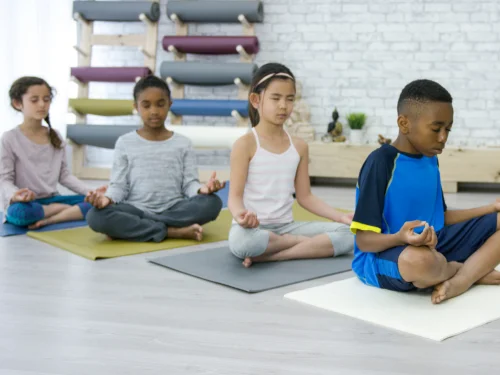How to Deal With Sensory Overload: Triggers, Symptoms, and Calming Strategies

Yes—finger plays, clapping games, and dance routines that use hand gestures all help. Combine rhythm and repetition for deeper learning.
Send home simple activity ideas, kits, or worksheets. Offer short instructions and encourage family involvement. Regular practice builds lasting progress.
Try origami, sticker scenes, stringing pasta, or painting with Q-tips. Crafts that use small pieces build precision and control.
Sensory overload can feel like the world is closing in — like too many tabs are open in your brain and none of them will shut. Whether it’s the roar of a crowd, flashing lights, strong smells, or even the texture of clothing, too much sensory input can overwhelm anyone. But with understanding, preparation, and the right strategies, it’s possible to regain calm and control.
What Is Sensory Overload?
.webp)
Sensory overload happens when the brain receives more input from the senses than it can process. Our nervous system is designed to filter and prioritize sensory information, but when this system is overwhelmed, it can trigger distress or even panic.
This overload can be caused by a single intense stimulus (like a siren) or a combination of moderate ones (e.g., bright lights and loud music and crowds).
Think of it like this: your brain is a busy airport terminal, and too many flights are arriving at once without anyone directing the traffic. Eventually, things shut down or crash.
Common Triggers: What Can Set Off Sensory Overload?
.webp)
Each person’s sensory threshold is different. What feels like background noise to one person can be unbearable for another. Here are examples of sensory triggers by sense:
🔊 Sound
- Crowded spaces with overlapping conversations
- Sirens, alarms, or loud appliances
- High-pitched or sudden noises
👀 Sight
- Flashing or flickering lights
- Visual clutter or too much movement in a space
- Bright sunlight or glare
👃 Smell
- Strong perfumes or air fresheners
- Cleaning chemicals
- Overwhelming food odors
🧂 Taste
- Spicy, sour, or bitter foods
- Unexpected food textures
- New or unfamiliar flavors
🖐️ Touch
- Tight clothing, scratchy tags or seams
- Sticky or messy substances
- Sudden or unexpected physical contact
Recognizing the Symptoms
.webp)
Sensory overload may look different from person to person, but here are some common emotional, physical, and behavioral signs:
Emotional Responses
- Anxiety or panic
- Irritability or anger
- Feeling overwhelmed or out of control
Physical Responses
- Sweating or flushed skin
- Shaking or trembling
- Racing heart
- Headaches or dizziness
Behavioral Responses
- Withdrawing from a situation
- Covering ears or eyes
- Pacing or stimming (repetitive movements)
- Meltdowns in children or shutdowns in adults
Who Is Most Affected?
While anyone can experience sensory overload, it is more commonly reported among individuals with:
- Autism Spectrum Disorder (ASD)
- ADHD (Attention-Deficit/Hyperactivity Disorder)
- PTSD (Post-Traumatic Stress Disorder)
- Sensory Processing Disorder (SPD)
That said, sensory overload can also occur in people without any specific diagnosis — especially when they’re stressed, tired, hungry, or overwhelmed by change.
Coping Strategies: What You Can Do in the Moment
.webp)
When sensory overload hits, it’s important to have a toolkit of strategies to ground and calm yourself. Here are some methods that work for both kids and adults:
1. Breathing Techniques
Try the 3-3-3 Method:
- Inhale through the nose for 3 counts
- Hold for 3 counts
- Exhale through the mouth for 3 counts
This simple act of controlled breathing helps calm the nervous system and redirects focus.
2. Create a Calm Space
- Step away from the environment, if possible
- Dim the lights, reduce noise, and remove visual clutter
- Use calming items like weighted blankets, fidget tools, or soft textures
3. Grounding Activities
- Name five things you see, four you can touch, three you hear, two you smell, and one you taste
- Hold something cold or textured to redirect tactile input
- Use calming scents like lavender (if not a trigger)
Long-Term Management: Preventing Future Overwhelm
🌱 Identify Your Triggers
Keep a journal or checklist to track when and where sensory overload occurs. Patterns will begin to emerge — maybe it’s large crowds, specific fabrics, or certain sounds.
🧘 Practice Regular Self-Regulation
- Meditate, do yoga, or take mindful walks
- Use soothing routines to help regulate daily stress
- Integrate sensory-friendly items at home and in workspaces
🎧 Use Protective Tools
- Noise-canceling headphones
- Sunglasses or hats for visual sensitivity
- Soft, seamless clothing
🗣️ Set Boundaries
Don’t be afraid to say no to environments or tasks that feel overwhelming. Give yourself permission to leave a room, skip an event, or request accommodations.
Supporting Children Through Sensory Overload
Children often lack the vocabulary to describe what they’re experiencing, which may lead to outbursts or meltdowns. Here’s how to help:
- Validate their feelings: “It’s okay to feel overwhelmed.”
- Offer choices: “Do you want to go outside or cuddle with your blanket?”
- Use sensory tools: chewable jewelry, soft toys, noise-reducing headphones
- Create predictable routines to reduce unexpected input
When to Seek Help

If sensory overload is interfering with your daily life, relationships, or emotional well-being, it may be time to speak with a therapist, occupational therapist, or sensory specialist. Professional guidance can help build customized coping strategies and offer support through related conditions like anxiety, ADHD, or autism.
You May Also Like: 15 Impulse Control Activities for Kids: Fun Ways to Build Self-Regulation
A Quick Sensory Trigger Checklist
Use this checklist to begin identifying your common sensory triggers:
Check off any that apply and reflect on how they affect you or your child. Awareness is the first step toward empowerment.
You May Also Like: Estrogen-Rich Foods for Menopause: A Natural Approach to Hormonal Balance
Final Thoughts
.webp)
Sensory overload is real — and you're not alone. Whether it shows up as irritability in a noisy room or anxiety from scratchy clothes, your experience is valid. By identifying triggers, using calming strategies, and seeking support when needed, you can transform overwhelm into resilience.
Instead of just surviving sensory-rich environments, you can learn to navigate them with confidence and clarity.
You May Also Like: Does Cooking Vegetables Remove Nutrients: Understanding Nutrient Retention




